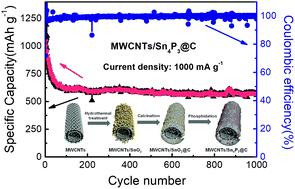当前位置:
X-MOL 学术
›
Inorg. Chem. Front.
›
论文详情
Our official English website, www.x-mol.net, welcomes your
feedback! (Note: you will need to create a separate account there.)
One-dimensional coaxial cable-like MWCNTs/Sn4P3@C as an anode material with long-term durability for lithium ion batteries
Inorganic Chemistry Frontiers ( IF 6.1 ) Pub Date : 2020-06-03 , DOI: 10.1039/d0qi00373e Shuting Sun 1, 2, 3, 4, 5 , Ruhong Li 1, 2, 3, 4, 5 , Wenhui Wang 3, 5, 6, 7 , Deying Mu 1, 2, 3, 4, 5 , Jianchao Liu 1, 2, 3, 4, 5 , Tianrui Chen 1, 2, 3, 4, 5 , Shuang Tian 5, 8, 9, 10 , Weimin Zhu 5, 11, 12, 13 , Changsong Dai 1, 2, 3, 4, 5
Inorganic Chemistry Frontiers ( IF 6.1 ) Pub Date : 2020-06-03 , DOI: 10.1039/d0qi00373e Shuting Sun 1, 2, 3, 4, 5 , Ruhong Li 1, 2, 3, 4, 5 , Wenhui Wang 3, 5, 6, 7 , Deying Mu 1, 2, 3, 4, 5 , Jianchao Liu 1, 2, 3, 4, 5 , Tianrui Chen 1, 2, 3, 4, 5 , Shuang Tian 5, 8, 9, 10 , Weimin Zhu 5, 11, 12, 13 , Changsong Dai 1, 2, 3, 4, 5
Affiliation

|
High capacity Sn4P3 is considered as a promising anode candidate for lithium-ion batteries (LIBs), but the fast capacity decay caused by the enormous volume changes and tin agglomeration during cycling largely limits its practical applications. Herein, MWCNTs/Sn4P3@C with a coaxial cable-like structure is designed, where a carbon protective layer is wrapped on the surfaces of Sn4P3 nanoparticles to minimize their exposure to the electrolyte and multi-walled carbon nanotubes (MWCNTs) serve as a conductive backbone to disperse Sn4P3 nanoparticles. When applied as the lithium container, the MWCNTs/Sn4P3@C composites demonstrate excellent cycling stability (delivering a high reversible capacity of 768.8 mA h g−1 after 100 cycles at 100 mA g−1 and 569.5 mA h g−1 after 1000 cycles at 1000 mA g−1) and rate capability (a de-lithiation capacity of 520.1 mA h g−1 maintained at a high current density of 2000 mA g−1). Furthermore, full cells composed of the MWCNTs/Sn4P3@C anode and the commercially available LiNi1/3Mn1/3Co1/3O2 cathode were also assembled. The result of cycling performance showed a reversible capacity of 507 mA h g−1 after 100 cycles, which is far superior to that of bare Sn4P3 and MWCNTs/Sn4P3 anodes with the reversible capacity lower than 100 mA h g−1. These excellent electrochemical performances originate from a synergistic effect between the MWCNT conductive backbone and carbon shell protective layer. The MWCNT backbone can enhance the conductivity and serve as a framework to disperse Sn4P3 nanoparticles, thus helping to accommodate the large volume changes during cycling, while the carbon shell not only can further enhance the conductivity but also minimize the side reaction between Sn4P3 nanoparticles and electrolytes.
中文翻译:

一维同轴电缆状MWCNTs / Sn4P3 @ C作为锂离子电池的长期耐用阳极材料
高容量的Sn 4 P 3被认为是锂离子电池(LIB)的有希望的阳极候选材料,但是循环过程中巨大的体积变化和锡结块导致的快速容量衰减极大地限制了其实际应用。本文设计了具有同轴电缆状结构的MWCNTs / Sn 4 P 3 @C,其中在Sn 4 P 3纳米颗粒的表面包裹了碳保护层,以最大程度地减少它们在电解质和多壁碳纳米管中的暴露( MWCNT)用作分散Sn 4 P 3纳米粒子的导电骨架。当用作锂容器时,MWCNTs / Sn 4 P3层@C复合材料显示出优异的循环稳定性(递送768.8毫安Hg的高可逆容量-1在100mA克100次循环后-1和569.5毫安汞柱-1之后以1000mA克1000次循环-1和倍率性能(a)中在2000 mA g -1的高电流密度下保持520.1 mA hg -1的去锂能力。此外,全电池由MWCNTs / Sn 4 P 3 @C阳极和市售的LiNi 1/3 Mn 1/3 Co 1/3 O 2组成阴极也被组装。循环性能的结果表明,经过100次循环后,可逆容量为507 mA hg -1,这远远优于裸Sn 4 P 3和MWCNTs / Sn 4 P 3阳极,可逆容量低于100 mA hg -1。这些出色的电化学性能源于MWCNT导电骨架和碳壳保护层之间的协同作用。MWCNT主链可以增强导电性,并可以作为分散Sn 4 P 3的骨架因此,碳壳不仅可以进一步提高电导率,而且还可以最大程度地减少Sn 4 P 3纳米颗粒与电解质之间的副反应。
更新日期:2020-07-14
中文翻译:

一维同轴电缆状MWCNTs / Sn4P3 @ C作为锂离子电池的长期耐用阳极材料
高容量的Sn 4 P 3被认为是锂离子电池(LIB)的有希望的阳极候选材料,但是循环过程中巨大的体积变化和锡结块导致的快速容量衰减极大地限制了其实际应用。本文设计了具有同轴电缆状结构的MWCNTs / Sn 4 P 3 @C,其中在Sn 4 P 3纳米颗粒的表面包裹了碳保护层,以最大程度地减少它们在电解质和多壁碳纳米管中的暴露( MWCNT)用作分散Sn 4 P 3纳米粒子的导电骨架。当用作锂容器时,MWCNTs / Sn 4 P3层@C复合材料显示出优异的循环稳定性(递送768.8毫安Hg的高可逆容量-1在100mA克100次循环后-1和569.5毫安汞柱-1之后以1000mA克1000次循环-1和倍率性能(a)中在2000 mA g -1的高电流密度下保持520.1 mA hg -1的去锂能力。此外,全电池由MWCNTs / Sn 4 P 3 @C阳极和市售的LiNi 1/3 Mn 1/3 Co 1/3 O 2组成阴极也被组装。循环性能的结果表明,经过100次循环后,可逆容量为507 mA hg -1,这远远优于裸Sn 4 P 3和MWCNTs / Sn 4 P 3阳极,可逆容量低于100 mA hg -1。这些出色的电化学性能源于MWCNT导电骨架和碳壳保护层之间的协同作用。MWCNT主链可以增强导电性,并可以作为分散Sn 4 P 3的骨架因此,碳壳不仅可以进一步提高电导率,而且还可以最大程度地减少Sn 4 P 3纳米颗粒与电解质之间的副反应。











































 京公网安备 11010802027423号
京公网安备 11010802027423号